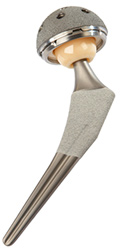Ceramic Materials Offer the Potential for a Longer-Lasting Hip Replacement
Conventional hip replacement systems use an insert made of plastic and a head made of metal. Over time, these components may wear as the parts move back and forth with normal joint use. Eventually, this may lead to the joint wearing out, and an additional surgery or “revision” is needed to replace the worn-out joint.
As total hip replacement becomes more common in younger and more active patients, and as patient life expectancies continue to increase, the orthopaedic industry has been challenged to extend the life span of total hip replacement components.
The clinical use of ceramic as a bearing surface dates back to the early 1970s. In 1995, an improved alumina ceramic was developed that had increased purity and strength over the first generation materials. The type of ceramic used in total hip replacement today is aluminum oxide, also known as alumina.
The extreme hardness of this type of ceramic offers greater scratch resistance than the conventional implants used in conventional hip replacements.1 Ceramic-on-ceramic surfaces have demonstrated significantly lower wear versus conventional plastic-on-metal hip systems in the laboratory.2 Therefore, it is anticipated that these improved wear characteristics may extend the life of the implant.

The best type of replacement for you depends on your medical condition, activity level, and age. Talk to your orthopaedic specialist to find out if a ceramic-on-ceramic hip replacement is right for you.
References:
1. http://www.amfed.org/t_mohs.htm – January 2006
2. Taylor SK, Serekian P, Manley M. “Wear Performance of a Contemporary Alumina: Alumina Bearing Couple Under Hip Joint Simulation: Trans 44th Ann. Mtg. ORM, 51, 1998.
